Sunday, September 1, 2013
Rovinj to Pula to Korenica (Plitvice Lakes)
For breakfast we had leftover pizza and mixed meat from last
night. Then we both took cold showers, deciding it must have
slipped the owner's mind to turn on the hot water for us. But
shortly before we left, I found a switch in the front entranceway
of the apartment that didn't activate any lights and discovered
that it turns on the water heater. Good to know! Too bad we didn't
learn this earlier. Anyway, now we'll know what to look for at the
next place.
At 10:00 we drove back toward the Old Town to take a photo of
Rovinj in the daylight. What a beautiful place! The coast here is a
popular destination for nudists, but we didn't see any. I was
disappointed at first, but as we traveled along for the next week
and a half and saw all the fat, hairy men in their Speedos, my
disappointment turned to relief.
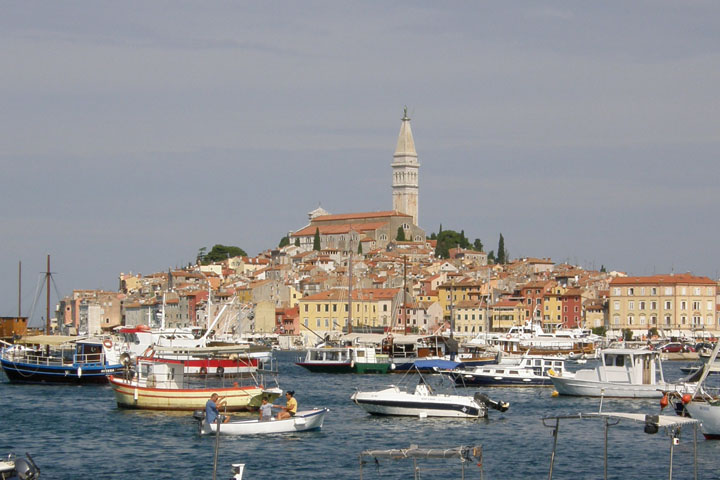
Rovinj by
day
This morning we got gas for the first time since arriving in
Europe. Our little Toledo car takes the lowest octane gas they sell
here, 95, which is higher than the highest octane we have at home.
It cost 10.51 kuna per liter, over $7 per gallon! It was $92 to
fill up our little rental car, and we weren't even on empty.
Gag.
It was an hour to Pula, on the southern tip of the peninsula, where
we spent a couple of hours checking out the Old Town, known for its
many surviving ancient Roman buildings. The Pula Colosseum, also
called the Amphitheater or the Arena, was built between 27 B.C. and
68 A.D. It's the sixth largest remaining Roman ruin in the world
and one of the best preserved. They still hold concerts here (we
just missed Joe Cocker), though recently they've had to limit the
decibel level due to damage to the rocks.
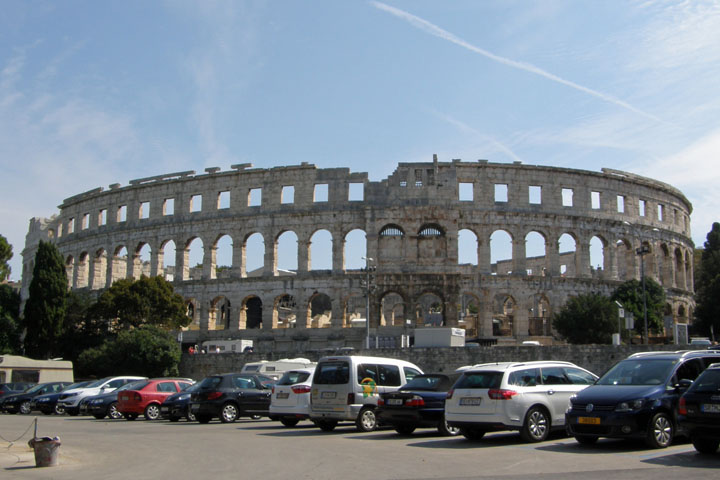
Pula
Arena
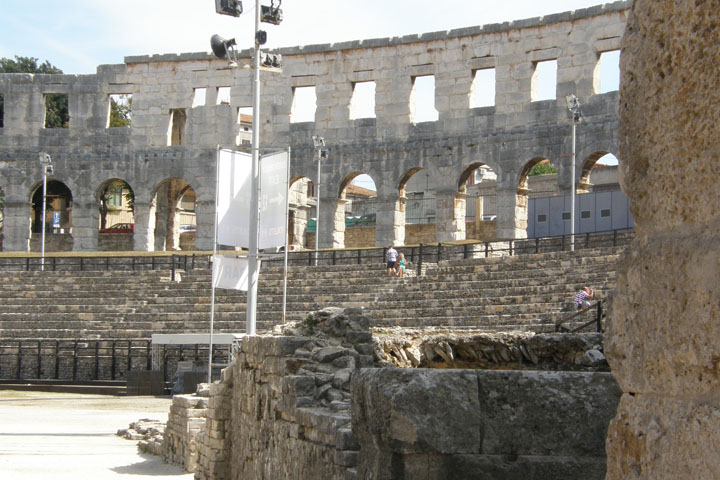
Inside the
Arena
Walking around the Old Town, one of the first things we saw was a
partially excavated Roman ruin behind a chain-link fence, in front
of some ugly apartments. Here someone was trying to build a parking
garage and discovered a bunch of darn historical artifacts on their
property. Now construction is halted pending excavation. Happens
all the time. I don't know how they ever get anything built.
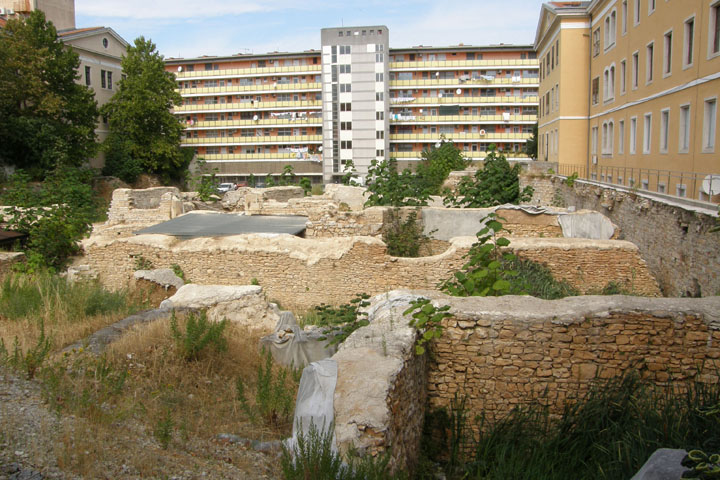
Progress
halted
In the Forum, or main square, is the Temple of Augustus, built in
the 1st century A.D. to honor Augustus Caesar. During World War II,
the temple was damaged by a direct hit from an Allied bomb. After
the war, the Allies patched it back up. You can see the patchwork
on the side of the building. I walked up the steps onto the portico
to look at a sculpture, but I quickly hurried on, because the whole
thing seemed like it could come tumbling down at any moment.

Temple of
Augustus
A 2nd century Rimski Mozaik (Roman Mosaic) was uncovered in the Old
Town during cleanup from a WWII Allied bombing. Now it's on display
behind a protective metal grill at the rear of an apartment block,
just off the main pedestrian drag. Very ornate. Remember, this was
someone's floor!
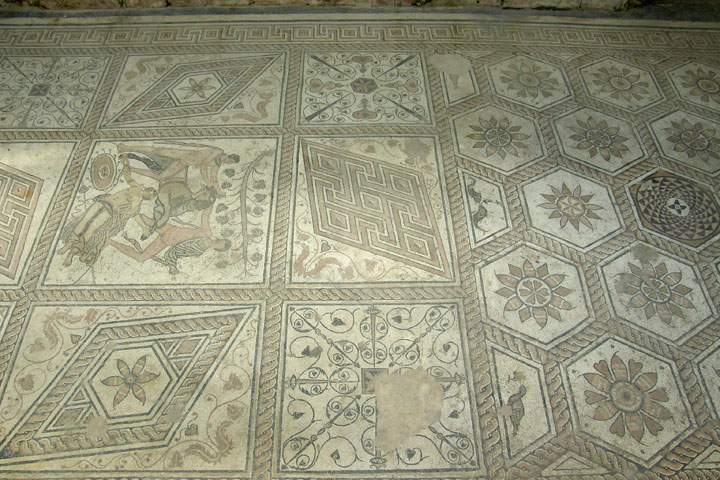
Rimski
Mozaik
The Arch of the Sergii, built around 29-27 B.C., is the last old
thing of note we saw in Pula. The triumphal arch used to be a city
gate and honors three brothers with the last name Sergii who were
victorious in the Battle of Actium, which apparently was super
important or something. An inscription indicates that the honored
brothers' sister paid for the arch, so I wonder how important the
battle was, really.
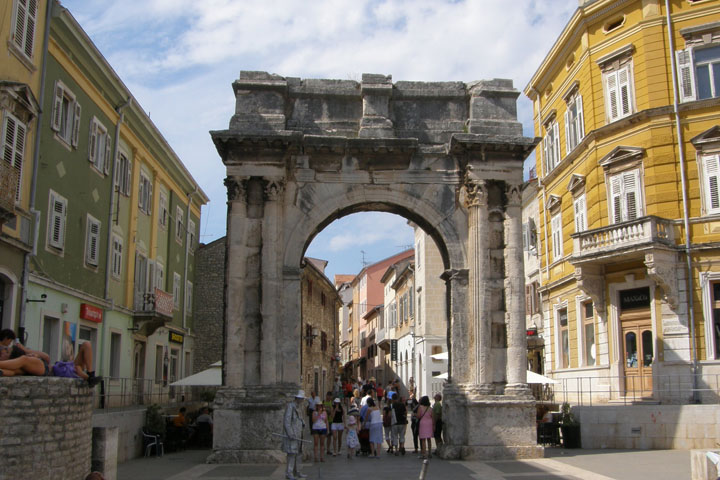
Arch of
Sergii
Not everything in Pula is old and cool. This is Istria's biggest
city (population 62,000) and an industrial port town, and it's got
plenty of congestion, grime, sex shops, and tacky souvenirs. We
liked it!
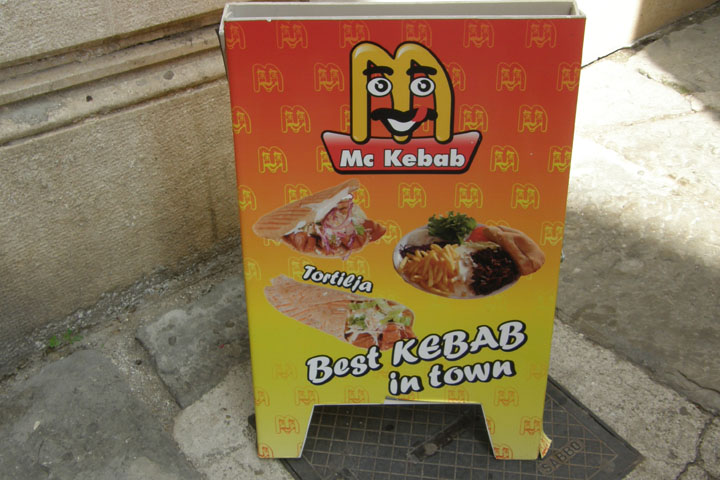
Possible trademark
infringement?
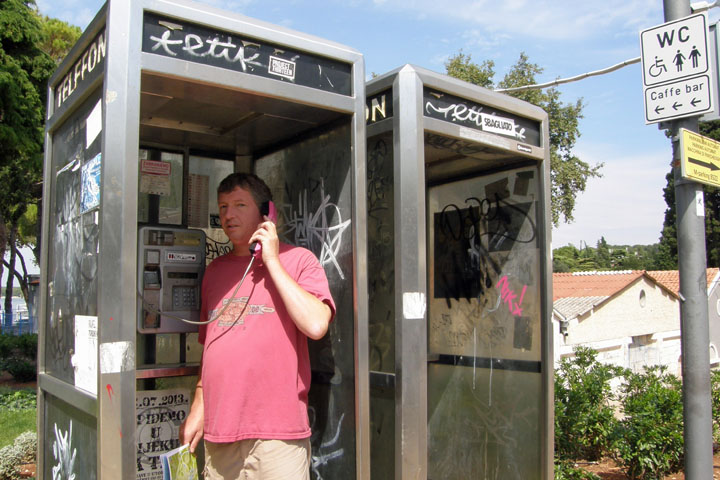
Tom, before changing
into a superhero!
In the early afternoon we headed toward Plitvice Lakes National
Park, which we'll be visiting tomorrow. I drove part of the way on
the Ipsilon Highway, a four-lane (sometimes more) toll road that we
took northeast off the Istrian Peninsula. All the interstate-type
highways in Croatia are expensive toll roads, so there's usually
not much traffic. It's 40 kuna per 100 kilometers, plus an extra
fee for some of the longer tunnels. That's a little over 7 bucks
per 60 miles. Expensive, but you can really save some time if you
need to.
The scenery when we emerged from the tunnel near Opatija, just off
the peninsula, was dramatic but not really photogenic. We had a
panoramic view of the dry, rocky, Dalmatian Mountains to our left
and the Adriatic Sea to our right. We went around the huge
industrial city of Rijeka and then left the toll road for the D8
coastal road, passing through many little resort towns along the
way.
At Senj we turned away from the coast onto D23, a steep, twisty
road from hell. I took a Dramamine and managed not to get sick, but
I did get a little woozy. We stopped at the high point of the road
so I could get some air and found a random little abandoned castle
of a one-time aspiring dictator that we were able to explore. It
was very windy up there, and the temperature had dropped
dramatically since we'd left the coast.
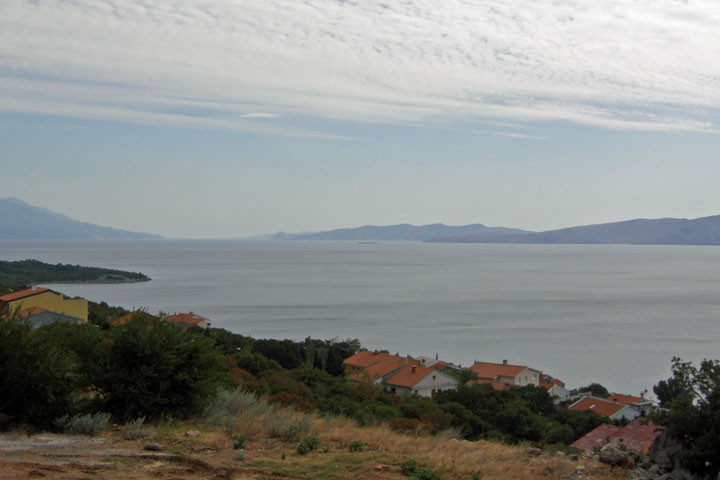
Scenic
overlook
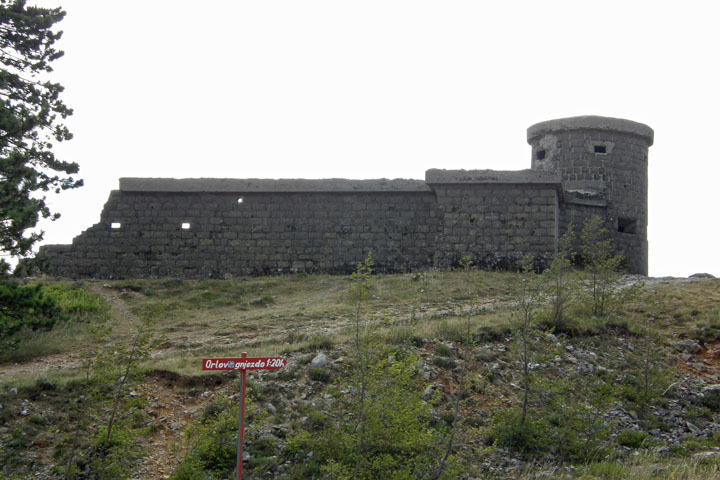
Seat of an abandoned
mini-kingdom
From D23, we turned onto D50 and then D52. All along these roads
there were roadside stands with people selling wheels of cheese,
jars of honey, and bottles of local mead and honey-based liqueurs.
Yes, of course we stopped! I didn't know what we'd do with an
entire wheel of cheese or jar of honey while on vacation, so we
were forced to buy the liqueur. We got a liter of pear, a half
liter of walnut, and a half liter of mead. All of it was good, but
it was waaaaaay too sweet. Naturally, we drank it anyway.
The area around Plitvice Lakes saw some of the heaviest fighting
during the Croatian War of Independence, fought from 1991 to 1995.
In fact, the first shots of the war were fired at Plitvice. In the
village of Zaluznica we passed several war-damaged homes and a
small memorial to those lost. We ended up seeing a lot more war
damage and many, many more memorials during the rest of our travels
throughout the region.
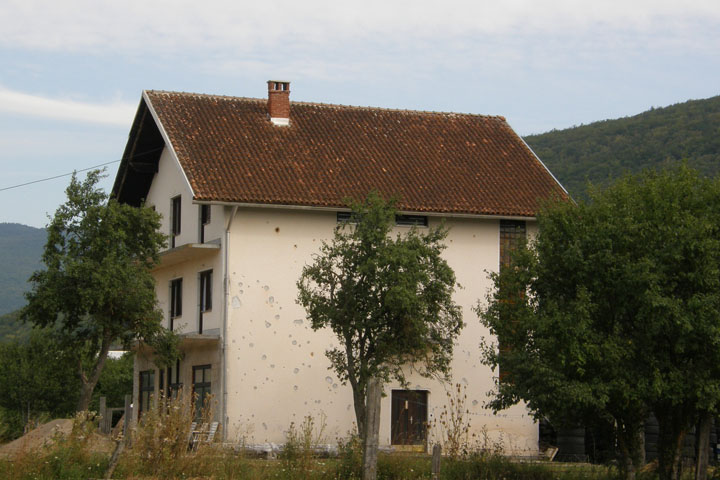
War damage,
Zaluznica
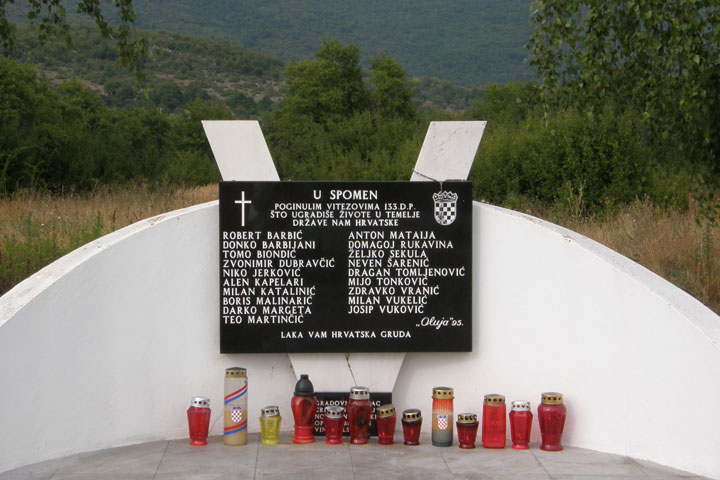
War
memorial
At 5:30 we arrived at House Mara, outside Korenica, situated in a very lovely
countryside setting near Plitvice Lakes. Our hostess, Bojana,
greeted us at the door, showed us to our room, and then helped us
plan our day at the national park tomorrow. She is a wealth of
information! Our room had a balcony with a very nice view of the
Croatian countryside and some beautiful mountains.
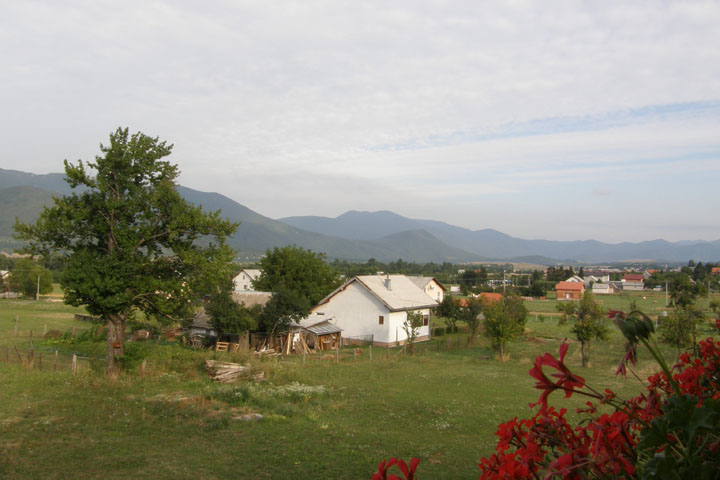
From our balcony in
Korenica
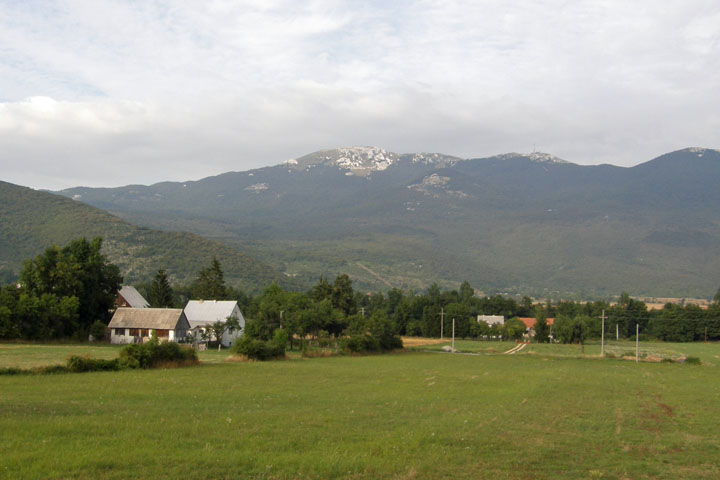
Also from our
balcony
Bojana recommended a couple of local restaurants, but the first one
we tried had a screaming baby, and the second one was packed, so we
wound up at a place we chose randomly on our own, Bistro
Pljesevica. At first I wrote down that the name of the restaurant
was “Jelovnik,” but then I decided that means “menu.” The Croatian
language isn't even slightly familiar! I had spaghetti bolognese,
and Tom had a ham sandwich. Again we were served a very mediocre
beer, Karlovacko this time. The food was fine. We especially
enjoyed the mixed salads.
Upon return to our soba, Bojana offered us each a shot of
slivovitsa, or homemade plum liqueur. Wowza! Now, Bojana speaks
English about as well as we do, but we did teach her one new word:
“moonshine.” It was fun to try, and it sure warmed our bellies!
We visited with Bojana in the lobby for a while. It was interesting
to get the thoughts of a local on Croatia's recent entry into the
EU. They've got a lot of freedom in Croatia, for example, the
freedom to make and share moonshine. I hope they can keep those
freedoms now that the EU is calling a lot of the shots. Time will
tell.
|














